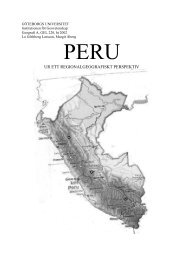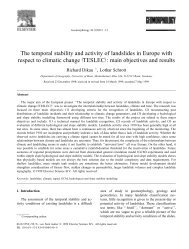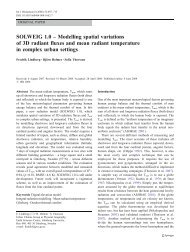AIR MASSES AND FRONTS
AIR MASSES AND FRONTS
AIR MASSES AND FRONTS
Create successful ePaper yourself
Turn your PDF publications into a flip-book with our unique Google optimized e-Paper software.
On this sounding the upper winds that show the<br />
greatest variation above the surface layer are those<br />
between the 800- to 650-mb layers. This indication<br />
coincides closely with the frontal indications of the<br />
temperature (T) and dew point (Td) curves (see fig.<br />
4-30). Since the wind veers with height through the<br />
layer, the front would be warm. The vertical wind shift<br />
through a frontal zone depends on the direction of the<br />
slope. In cold fronts the wind backs with height, while<br />
in warm fronts the wind veers with height. At the<br />
surface the wind always veers across the front, and the<br />
isobars have a sharp cyclonic bend or trough that points<br />
toward higher pressure. Sometimes the associated<br />
pressure trough is not coincident with the front; in such<br />
cases there may not be an appreciable wind shift across<br />
the front—only a speed discontinuity.<br />
Pressure<br />
One of the important characteristics of all fronts is<br />
that on both sides of a front the pressure is higher than<br />
at the front. This is true even though one of the air<br />
masses is relatively warm and the other is relatively<br />
cold. Fronts are associated with troughs of low<br />
pressure. (A trough is an elongated area of relatively<br />
low pressure.) A trough may have U-shaped or<br />
V-shaped isobars. How the pressure changes with the<br />
passage of a front is of prime importance when you are<br />
determining frontal passage and future movement.<br />
Friction causes the air (wind) near the ground to<br />
drift across the isobars toward lower pressure. This<br />
causes a drift of air toward the front from both sides.<br />
Since the air cannot disappear into the ground, it must<br />
move upward. Hence, there is always a net movement<br />
of air upward in the region of a front. This is an<br />
important characteristic of fronts, since the lifting of the<br />
air causes condensation, clouds, and weather.<br />
GENERAL CHARACTERISTICS OF <strong>FRONTS</strong><br />
All fronts have certain characteristics that are<br />
common and usually predictable for that type of front.<br />
Cold frontal weather differs from warm frontal<br />
weather, and not every cold front has the same weather<br />
associated with it. The weather, intensity of the<br />
weather, and the movement of fronts are, to a large<br />
degree, associated with the slope of the front.<br />
Frontal Slope<br />
When we speak of the slope of a front, we are<br />
speaking basically of the steepness of the frontal<br />
surface, using a vertical dimension and a horizontal<br />
4-30<br />
dimension. The vertical dimension used is normally 1<br />
mile. A slope of 1:50 (1 mile vertically for every 50<br />
miles horizontally) would be considered a steep slope,<br />
and a slope of 1:300 a gradual slope. Factors favoring a<br />
steep slope are a large wind velocity difference between<br />
air masses, small temperature difference, and high<br />
latitude.<br />
The frontal slope therefore depends on the latitude<br />
of the front, the wind speed, and the temperature<br />
difference between the air masses. Because cold air<br />
tends to under run warm air, the steeper the slope, the<br />
more intense the lifting and vertical motion of the warm<br />
air and, therefore the more intense the weather.<br />
Clouds and Weather<br />
Cloud decks are usually in the warm air mass<br />
because of the upward vertical movement of the warm<br />
air. Clouds forming in a cold air mass are caused by the<br />
evaporation of moisture from precipitation from the<br />
overlying warm air mass and/or by vertical lifting.<br />
Convergence at the front results in a lifting of both<br />
types of air. The stability of air masses determines the<br />
cloud and weather structure at the fronts as well as the<br />
weather in advance of the fronts.<br />
Frontal Intensity<br />
No completely acceptable set of criteria is in<br />
existence as to the determination of frontal intensity, as<br />
it depends upon a number of variables. Some of the<br />
criteria that may be helpful in delineating frontal<br />
intensity are discussed in the following paragraphs.<br />
TURBULENCE.—Except when turbulence or<br />
gustiness may result, weather phenomena are not taken<br />
into account when specifying frontal intensity, because<br />
a front is not defined in terms of weather. A front may<br />
be intense in terms of discontinuity of density across it,<br />
but may be accompanied by no weather phenomena<br />
other than strong winds and a drop in temperature. A<br />
front that would otherwise be classified as weak is<br />
considered moderate if turbulence and gustiness are<br />
prevalent along it, and an otherwise moderate front is<br />
classified as strong if sufficient turbulence and<br />
gustiness exist. The term gustiness for this purpose<br />
includes convective phenomena such as thunderstorms<br />
and strong winds.<br />
TEMPERATURE GRADIENT.—Temperature<br />
gradient, rather than true difference of temperature<br />
across the frontal surface, is used in defining the frontal<br />
intensity. Temperature gradient, when determining









